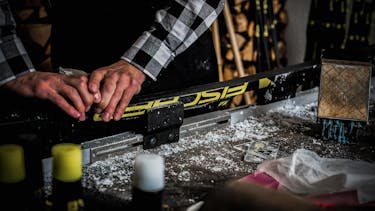Why do I have to wax cross-country skis?
"Waxing is so much effort" and "The skis are great anyway, they don't need waxing" or alternatively "Only professionals have to do that" - if someone wants to sell you such arguments, don't listen to it! Because only with a regularly waxed cross-country ski or skating ski will you really get the most out of your cross-country ski tour.
The reason for this is actually quite obvious: the wax layer protects the coating so that the ski can glide more easily through the snow. If the coating becomes brittle due to the ski receiving too little care, the increased friction will have a braking effect.

The basics of cross-country ski care
Skis want to be waxed, so there's no question about it. The situation is not quite as clear when it comes to the process itself. There are many wax products, as well as tips for frequency and the stubborn opinion that every cross-country ski has to be waxed from day one...
Do I have to wax new cross-country skis?
A new ski should be ready to go immediately. Therefore, you don't have to wax our cross-country skis before using them for the first time. You don't have to, but you can if you want to glide easily.
But even the best cross-country ski wants to be waxed sometime. After all, you glide on ice crystals - and they rub open the wax layer little by little each time you use them. This way the wax is removed piece by piece and sooner or later you will notice that without the occasional wax treatment gliding has become quite tedious...
Frequency: How often do I have to wax cross-country skis/skating skis?
If professionals wax their cross-country skis every day, does that mean that you have to invest time in ski care before every single tour as well? No, don't worry. Normally it is enough to take care of the wax layer every 2-3 days. This should be enough to ensure a constant gliding effect.
However, this is rather an indicative value, as it is difficult to provide general information in this case. Last but not least, how often you actually ski and what snow conditions prevail also plays an important role: Fresh snow crystals have a sharper structure than old, wet snow and therefore grind away the wax all the faster.
The most important rule of thumb is: As soon as you can see irregularities in the coating at first sight and at the latest when the black graphite coating turns grey, it's time for a wax treatment!
Accessories: Cold wax, liquid wax or simply candle wax?
I'm sure you've figured it out yourself: There are many ski waxes. In order for you to keep track of the differences, we have compiled the most important facts here in short!
- Climbing wax vs. glide wax: These types of wax have the opposite effect: Climbing wax causes a greater static friction in the climbing zone. This is an advantage if you don't have skis with a mechanical climbing aid (skin, or so-called "scales"), but are using a classic wax ski (more about this later). Glide wax, on the other hand, is - surprise, surprise - intended for gliding and reducing friction.
More and more people are getting interested in liquid waxes. These products are especially designed to be easy to apply. They don't need special premises or a mounting device. The waxing process is very simple and time-saving, which is ideal if you want to be prepared when going out while being able to wax again if needed.
So, what do you think about the ideal wax? Basically, the most important thing is being familiar with the wax and being able to use it correctly. You should also pay attention to the temperature specifications when buying your cross-country ski care product, since not every wax is suitable for every type of snow.
By the way, if you're wondering about any absolute no-go: You should never use regular candle wax for waxing your cross-country or skating skis. After all, you can never be sure which fragrances and dyes they contain and how well your ski can handle these additives.

Waxing classic cross-country skis vs. waxing skating skis
Classic wax skis, scale skis, skating skis - which is which and how do I wax them? Let's have a look at how the waxing of cross-country skis works with this step-by-step guide!
Option 1: Waxing wax skis or "scale skis"
A classic cross-country ski is divided into three zones: Glide zone - repulsion zone - glide zone. So naturally the whole ski is not treated exactly the same when waxing:
| Glide zone | Glide wax/liquid wax |
|---|---|
| Repulsion/Climbing zone | Climbing wax/liquid wax |
| Glide zone | Glide wax/liquid wax |
Climbing wax ensures that you have a firm grip on the ascent, while the glide zone, as the name suggests, shows its effect when gliding downhill. This type of ski structure is called wax ski; besides this there are also so-called "NoWax" skis.
These skis feature a mechanical climbing aid in the climbing zone which are commonly called "scales", crown grinding or skins. These are best treated using a liquid wax and are generally easy to clean. You don't need a special climbing wax for these skins, because the grip function comes with the ski. However, they should be cleaned with liquid wax so that wax residues or dirt picked up from the track doesn’t restrict the mechanical climbing aids function.
Option 2: Waxing skating skis
Climb and glide zone? Not when skating! These sporty cross-country skis have a glide zone throughout the entire ski. When you skate, all you need is glide wax - that's the big secret. Caution: When buying, pay attention to the optimal wax temperature condition!
Instructions: Correctly waxing your cross-country skis
Skating skis or classic cross-country skis are not that difficult to wax - especially not once you got a little practice. All you need is the right accessories:
For the simple version of liquid wax, you need nothing but a brush. Shake the bottle, apply the wax to the ski coating, allow it to dry and brush it off.
If you want to do your skis a favour, you can treat them to a hot wax now and then, which cares for them more intensively than the liquid wax quicky. The following accessories are necessary:
- a solid, stable foundation, e.g. a workbench
- a ski holder or a device which secures the ski from slipping
- a coating cleaner
- the right ski wax
- a scraper blade for removing the wax layer
- a nylon brush
- a groove pin
- a wax iron, if you work with hot wax
- a soft cloth
- Smoothen and prepare the surface coating by removing dirt with the coating cleaner.
- Thoroughly brush the surface once to remove any remaining dirt.
- Apply the wax to the gliding surfaces: You can apply cold wax directly. The hot wax block is simply held to the iron so the molten wax drips onto the ski.
- If you use hot wax, now is the time to evenly spread the liquid wax over the ski by using the wax iron. Caution: In case of smoke, remove the iron immediately! You can avoid this risk by using a wax iron that can be adjusted to different temperatures.
- Patience is a virtue: Grant the cold wax about 5-10 minutes and the hot wax approximately 20-30 minutes for hardening and absorption.
- Clean the groove in the coating using the groove pin. This is important for good control when gliding.
- Remove the remaining (hot) wax layer.
- Brush the coating several times.
- Wipe off any remaining wax flakes with the cloth.
Once you have done this a couple of times, waxing your cross-country skis won’t take long. A tip for "NoWax" skis: Glide wax does not belong on the climbing zone. These skis require special care for removing dirt from the "scales" or skins. Here the easiest applications are Clean & Glide products, which can be used for both climbing and gliding zones.

Should I have my cross-country skis waxed or wax them myself?
Most of us probably treat the alpine skis to the luxury of a professional ski service every now and then. But what about cross-country skis? Do you really have to go to experts every time, when waxing the skis several times a week?
Of course not. Provided you are familiar with the wax and know exactly which product is best for your skis, you can definitely wax your cross-country skis all by yourself. However, when it comes to major repairs, scratches, etc. you'd better let the pros have a look.
Finally, we want to recommend you investing in high-quality accessories, including a wax iron instead of some old iron at home. Or you could alternatively just go for liquid products instead. In both cases nothing should go wrong and you will feel the difference with your freshly waxed cross-country ski once hitting the slope: It really was worth it!


